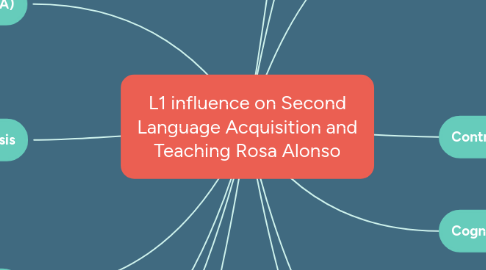
1. Teaching implications
1.1. Teachers
1.1.1. Teachers have an important role in the process of second language learning.
1.1.1.1. They helps L2 students internalize new concepts and become aware of differences in L1-L2 patterns
1.2. Native versus non-native teachers
1.2.1. Non-native teacher can present a role model for the students as she/he can codeswitch to the students’ own language when necessary.
1.2.2. The native teacher is a role model to be followed. He/She teaches students the mother tongue of a specific language.
1.3. Teaching materials and textbooks
1.3.1. Textbooks are materials that presented the same topics more than once and in different formats and language levels.
2. Error Analysis (EA)
2.1. Process of studying the errors which are made by L2 learners.
3. Creative Construction Hypothesis
3.1. Subconscious process by which language learners gradually organize the language they hear, according to the rules they construct to understand and generate sentences.
4. Interlanguage Hypothesis
4.1. It’s an independent system that combines both the L1 and the L2 structures. L2 learners use it to convey the target language.
5. The Multicompetence Framework
5.1. Refers to the knowledge of more than one language in the same mind.
6. Meaning Transfer
6.1. It refers to the influence of the semantics and pragmatics of the L1 on the L2.
7. Concept Transfer
7.1. It can be considered a subset of meaning transfer.
8. Interference
8.1. It happens when habits are transferred from the L1 to the L2.
8.2. It splits in terms transfer and term cross-linguistic influence (CLI)
8.2.1. Term transfer indicated any previous knowledge being applied to new knowledge.
8.2.2. Term cross-linguistic influence (CLI) refers to the knowledge we have in one language can affect the understanding and use of another
